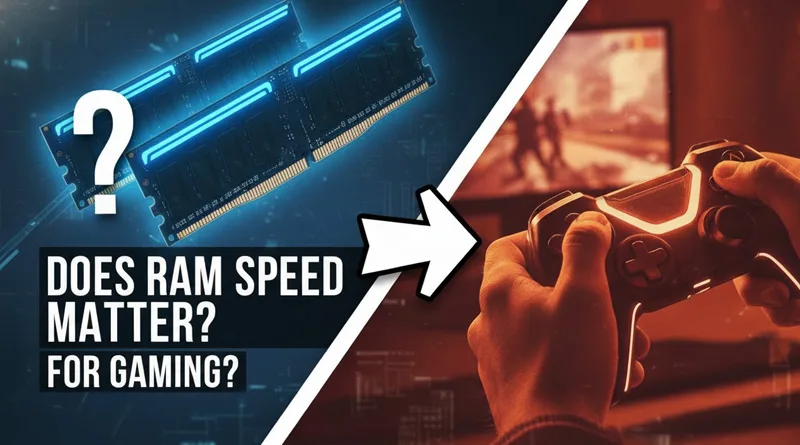For years, the conventional wisdom was simple: just get enough RAM, and the speed doesn’t matter much for gaming. With the shift to powerful modern CPUs like AMD’s Ryzen 7000 and Intel’s 14th Gen, that wisdom is now obsolete. The question of Does RAM Speed Matter for Gaming is more critical than ever. In short: Yes, absolutely. The fundamental question of Does RAM Speed Matter for Gaming has been answered by the new architecture.
The speed and, more importantly, the latency of your memory directly impact your CPU’s ability to feed data to the GPU. This guide provides a truth test, explaining why the switch to DDR5 has amplified the importance of both clock speed (MHz) and timing (CAS Latency) and how to ensure you’re getting the absolute best performance for your PC. Your journey begins with the motherboard you chose, which sets the speed limit. For our top motherboard recommendations that support the fastest RAM speeds, refer to our ultimate guide to the Best Gaming Motherboard.
The Core Concept: Why Does RAM Speed Matter for Gaming Now?
The main reason the answer to Does RAM Speed Matter for Gaming has changed is the architecture of modern CPUs.
The Infinity Fabric and Ryzen’s Thirst for Speed
AMD Ryzen CPUs rely heavily on the Infinity Fabric, an internal connection that links the processing cores. The clock speed of this fabric is directly tied to the speed of the RAM. Faster RAM allows the Infinity Fabric to run faster, reducing the time cores spend waiting for data. This translates directly to higher minimum FPS and reduced micro-stutters—a huge advantage in competitive titles.
The Intel Factor
While Intel CPUs are less dependent on this internal clock, faster memory still provides a significant boost, especially in CPU-intensive games or highly complex strategy titles. A fast RAM kit ensures the powerful cores are never left waiting for the next data packet.
The True Difference: Speed vs. Latency
RAM performance is a two-part equation. You cannot look at speed (MHz) alone; you must also consider latency.
1. Speed (Clock Rate – MHz)
This is the number you see advertised (e.g., 6000MHz). It represents how many data cycles the RAM can perform per second. Higher is always better, but only up to the limit set by your motherboard.
2. Latency (CAS Latency – CL)
This is the delay. CAS Latency (CL) is the number of clock cycles it takes for the RAM to respond to a request for data. A lower number here is always better. For example, CL30 is faster than CL40.
The Calculation: True Latency
To find the RAM’s true speed, you must combine the two. The true latency in nanoseconds (ns) is calculated as:

- Example 1 (Slow): 4800MHz CL40 = 16.6 ns
- Example 2 (Fast): 6000MHz CL30 = 10.0 ns
The faster kit has a much lower true latency, meaning the data gets to the CPU nearly 40% faster. This lower latency is what eliminates the annoying micro-stutters in demanding games.
The FPS Impact: Where You See the Difference
Does RAM Speed Matter for Gaming at 4K? Less so, because the GPU is the bottleneck. But the difference is huge where the CPU is the bottleneck.
1. Minimum FPS and Micro-Stutters
The most noticeable benefit of fast, low-latency RAM is the increase in 1% Low FPS (the worst frame rate you hit). Faster RAM reduces the CPU’s waiting time during intense scenes, raising the 1% Low FPS. This makes gameplay feel significantly smoother and more consistent.
2. Competitive Gaming
In games like Valorant, CS2, or Fortnite, every frame matters. Faster RAM ensures the CPU can handle the high frame rate, allowing the GPU to push out maximum FPS without being starved of draw-call data.
3. CPU Intensive Games
Games that involve complex AI, large simulations (like strategy games), or heavy physics calculations benefit massively from fast memory, as the CPU is constantly performing complex, data-intensive tasks.
The Crucial Role of Your Motherboard
The fastest RAM kit in the world is useless if your motherboard cannot support it. The motherboard sets the maximum speed limit for your memory.
1. The XMP/EXPO Gate: Enabling The Speed That Matters for Gaming
After installing your fast RAM, you must go into your motherboard’s BIOS and enable XMP (for Intel) or EXPO (for AMD). These are profiles that load the high speeds advertised on the box. If you skip this step, your high-end 6000MHz RAM may be running at a slow, default 4800MHz.
2. The QVL List
Before purchasing, always check your motherboard manufacturer’s QVL (Qualified Vendor List). This list specifies the exact RAM kits that have been successfully tested with your specific board. Using an unlisted kit risks stability issues or the inability to run at the advertised speeds.
3. Motherboard Chipset Limitations
While both B-series and Z-series/X-series motherboards support overclocking, the higher-end Z/X boards often have more robust traces and better BIOS support for extremely high memory speeds (over 7000MHz). This is why choosing the right Best Gaming Motherboard is the first step.
Conclusion: Stop Leaving FPS on the Table
The days of ignoring RAM speed are over. The answer to Does RAM Speed Matter for Gaming is a definitive yes, especially for Ryzen builders and users seeking to eliminate micro-stutters. When buying, look for a balance: High Speed (5600MHz – 6000MHz) combined with Low Latency (CL30 – CL36).
This is the sweet spot for DDR5 gaming performance today. Understanding how much Does RAM Speed Matter for Gaming should be your final check before purchase. After you choose your RAM, remember to always enable the XMP/EXPO profile in your motherboard’s BIOS!
For a final verdict on which motherboard supports the fastest and most stable memory speeds, and to view our ranked list, be sure to visit our ultimate guide to the Best Gaming Motherboard.


